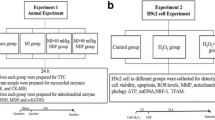Abstract
In previous work we have demonstrated increased expression of NOX2 in cardiomyocytes of infarcted human hearts. In the present manuscript we investigated the functional role of NOX2 in ischemically challenged H9c2 cells, a rat cardiomyoblast cell line, and adult rat cardiomyocytes. Expression of NOX2 in H9c2 cells was confirmed by RT-PCR. In Western-blot experiments, increased NOX2 expression was detected during ischemia, which was inhibited by transcription and translation inhibitors. Surprisingly, under ischemia, in addition to an increased cytosolic expression, NOX2 was localized mainly in the nucleus of apoptotic cardiomyocytes, where it colocalized with nitrotyrosine residues and activated caspase 3. Inhibition of reactive-oxygen-species generation with the flavoenzyme inhibitor diphenylene iodonium (DPI) and the NADPH-oxidase inhibitor apocynin led to a significantly decreased induction of apoptosis as assessed by quantification of caspase-3 activity and by TUNEL analysis. These results demonstrate that NOX2 is expressed in the nucleus of cardiomyocytes during apoptosis and that it likely participates in proapoptotic signaling. To the best of our knowledge, this is the first demonstration of nuclear NOX2 expression and its involvement in cardiomyocyte apoptosis.
Similar content being viewed by others
References
Lambeth JD. NOX enzymes and the biology of reactive oxygen. Nat Rev Immunol 2004; 4: 181–189.
Lassegue B, Clempus RE. Vascular NAD(P)H oxidases: Specific features, expression, and regulation. Am J Physiol Regul Integr Comp Physiol 2003; 285: R277–R297.
Griendling KK. Novel NAD(P)H oxidases in the cardiovascular system. Heart 2004; 90: 491–493.
Krijnen PA, Meischl C, Hack CE, et al. Increased Nox2 expression in human cardiomyocytes after acute myocardial infarction. J Clin Pathol 2003; 56: 194–199.
Heymes C, Bendall JK, Ratajczak P, et al. Increased myocardial NADPH oxidase activity in human heart failure. J Am Coll Cardiol 2003; 41: 2164–2171.
Byrne JA, Grieve DJ, Bendall JK, et al. Contrasting roles of NADPH oxidase isoforms in pressure-overload versus angiotensin II-induced cardiac hypertrophy. Circ Res 2003; 93: 802–805.
Ushio-Fukai M, Tang Y, Fukai T, et al. Novel role of gp91(phox)-containing NAD(P)H oxidase in vascular endothelial growth factor-induced signaling and angiogenesis. Circ Res 2002; 91: 1160–1167.
Chen Z, Keaney JF, Jr., Schulz E, et al. Decreased neointimal formation in Nox2-deficient mice reveals a direct role for NADPH oxidase in the response to arterial injury. Proc Natl Acad Sci USA 2004; 101: 13014–13019.
Milovanova T, Chatterjee S, Manevich Y, et al. Lung endothelial cell proliferation with decreased shear stress is mediated by reactive oxygen species. Am J Physiol Cell Physiol 2005; 290: C66–C76.
Hiraoka W, Vazquez N, Nieves-Neira W, Chanock SJ, Pommier Y. Role of oxygen radicals generated by NADPH oxidase in apoptosis induced in human leukemia cells. J Clin Invest 1998; 102: 1961–1968.
Grishko V, Pastukh V, Solodushko V, Gillespie M, Azuma J, Schaffer S. Apoptotic cascade initiated by angiotensin II in neonatal cardiomyocytes: Role of DNA damage. Am J Physiol Heart Circ Physiol 2003; 285: H2364–H2372.
Sanford AN, Suriano AR, Herche D, Dietzmann K, Sullivan KE. Abnormal apoptosis in chronic granulomatous disease and autoantibody production characteristic of lupus. Rheumatology (Oxford) 2005; 45: 178–181.
Nijmeijer R, Willemsen M, Meijer CJ, et al. Type II secretory phospholipase A2 binds to ischemic flip-flopped cardiomyocytes and subsequently induces cell death. Am J Physiol Heart Circ Physiol 2003; 285: H2218–H2224.
Souren JE, Van Der MC, Van Wijk R. NADPH-oxidase-dependent superoxide production by myocyte-derived H9c2 cells: influence of ischemia, heat shock, cycloheximide and cytochalasin D. J Mol Cell Cardiol 1997; 29: 2803–2812.
Privratsky JR, Wold LE, Sowers JR, Quinn MT, Ren J. AT1 blockade prevents glucose-induced cardiac dysfunction in ventricular myocytes: Role of the AT1 receptor and NADPH oxidase. Hypertension 2003; 42: 206–212.
Verhoeven AJ, Bolscher BG, Meerhof LJ, et al. Characterization of two monoclonal antibodies against cytochrome b558 of human neutrophils. Blood 1989; 73: 1686–1694.
Xiao L, Pimentel DR, Wang J, Singh K, Colucci WS, Sawyer DB. Role of reactive oxygen species and NAD(P)H oxidase in alpha(1)-adrenoceptor signaling in adult rat cardiac myocytes. Am J Physiol Cell Physiol 2002; 282: C926–C934.
Duncan MW. A review of approaches to the analysis of 3-nitrotyrosine. Amino Acids 2003; 25: 351–361.
Carmody RJ, Cotter TG. Signalling apoptosis: A radical approach. Redox Rep 2001; 6: 77–90.
Kumar D, Jugdutt BI. Apoptosis and oxidants in the heart. J Lab Clin Med 2003; 142: 288–297.
Taniyama Y, Griendling KK. Reactive oxygen species in the vasculature: Molecular and cellular mechanisms. Hypertension 2003; 42: 1075–1081.
Zhao ZQ. Oxidative stress-elicited myocardial apoptosis during reperfusion. Curr Opin Pharmacol 2004; 4: 159–165.
Chakrabarti S, Hoque AN, Karmazyn M. A rapid ischemia-induced apoptosis in isolated rat hearts and its attenuation by the sodium-hydrogen exchange inhibitor HOE 642 (cariporide). J Mol Cell Cardiol 1997; 29: 3169–3174.
Czerski L, Nunez G. Apoptosome formation and caspase activation: Is it different in the heart? J Mol Cell Cardiol 2004; 37: 643–652.
Graham RM, Frazier DP, Thompson JW, et al. A unique pathway of cardiac myocyte death caused by hypoxia-acidosis. J Exp Biol 2004; 207: 3189–3200.
Morel Y, Barouki R. Repression of gene expression by oxidative stress. Biochem J 1999; 342 Pt 3: 481–496.
Author information
Authors and Affiliations
Corresponding author
Additional information
The first two authors contributed equally.
Rights and permissions
About this article
Cite this article
Meischl, C., Krijnen, P.A.J., Sipkens, J.A. et al. Ischemia induces nuclear NOX2 expression in cardiomyocytes and subsequently activates apoptosis. Apoptosis 11, 913–921 (2006). https://doi.org/10.1007/s10495-006-6304-7
Published:
Issue Date:
DOI: https://doi.org/10.1007/s10495-006-6304-7




